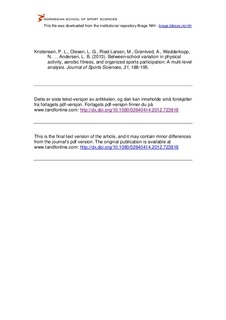| dc.contributor.author | Kristensen, Peter L. | |
| dc.contributor.author | Olesen, Line G. | |
| dc.contributor.author | Ried-Larsen, Mathias | |
| dc.contributor.author | Grøntved, Anders | |
| dc.contributor.author | Wedderkopp, Niels | |
| dc.contributor.author | Froberg, Karsten | |
| dc.contributor.author | Andersen, Lars Bo | |
| dc.date.accessioned | 2014-03-06T12:55:48Z | |
| dc.date.available | 2014-03-06T12:55:48Z | |
| dc.date.issued | 2012-09-20 | |
| dc.identifier.citation | Journal of Sports Sciences. 2013, 31, 188-195 | nb_NO |
| dc.identifier.uri | http://hdl.handle.net/11250/191275 | |
| dc.description | I Brage finner du siste tekst-versjon av artikkelen, og den kan inneholde ubetydelige forskjeller fra forlagets pdf-versjon. Forlagets pdf-versjon finner du på www.tandfonline.com: http://dx.doi.org/10.1080/02640414.2012.723818 / In Brage you'll find the final text version of the article, and it may contain insignificant differences from the journal's pdf version. The definitive version is available at www.tandfonline.com: http://dx.doi.org/10.1080/02640414.2012.723818 | nb_NO |
| dc.description.abstract | A large proportion of a child's day is spent at school interacting with certain physical surroundings, teachers, and school friends. Thus, schools could have a marked impact on establishing physical activity habits. The aim of the present study was to assess between-school variation in physical activity, aerobic fitness, and organized sports participation. Altogether, we tested 1766 nine- and fifteen-year-old children attending 242 school classes at 35 different schools in Denmark in 1997–2003. The intra-class correlation coefficient (ICC) for objectively assessed physical activity ranged between 0.06 and 0.18 depending on the dimension of physical activity and the time considered (i.e. school time vs. leisure time). For aerobic fitness, an ICC of 0.10 was observed, whereas that for organized sports participation ranged between 0.01 and 0.10 depending on the age group. Studying between-school variation in physical activity provides information about the extent to which children adjust their physical activity habits according to the social and environmental circumstances that they share, and helps to plan future school-based physical activity studies, especially in terms of sample size and power calculation. | nb_NO |
| dc.language.iso | eng | nb_NO |
| dc.publisher | Taylor & Francis | nb_NO |
| dc.subject | VDP::Samfunnsvitenskap: 200::Samfunnsvitenskapelige idrettsfag: 330::Andre idrettsfag: 339 | nb_NO |
| dc.subject | schools | nb_NO |
| dc.subject | physical activity | nb_NO |
| dc.subject | cluster analysis | nb_NO |
| dc.subject | physical fitness | nb_NO |
| dc.title | Between-school variation in physical activity, aerobic fitness, and organized sports participation: A multi-level analysis | nb_NO |
| dc.type | Journal article | nb_NO |
| dc.type | Peer reviewed | nb_NO |
| dc.source.journal | Journal of Sports Sciences | nb_NO |
| dc.identifier.doi | 10.1080/02640414.2012.723818 | |
| dc.description.localcode | Seksjon for idrettsmedisinske fag / Department of Sport Sciences | nb_NO |
